CRIMINAL LAW. CRIMINAL LAW Name of the Student: Name of
VerifiedAdded on 2023/01/16
|12
|3333
|39
AI Summary
Contribute Materials
Your contribution can guide someone’s learning journey. Share your
documents today.
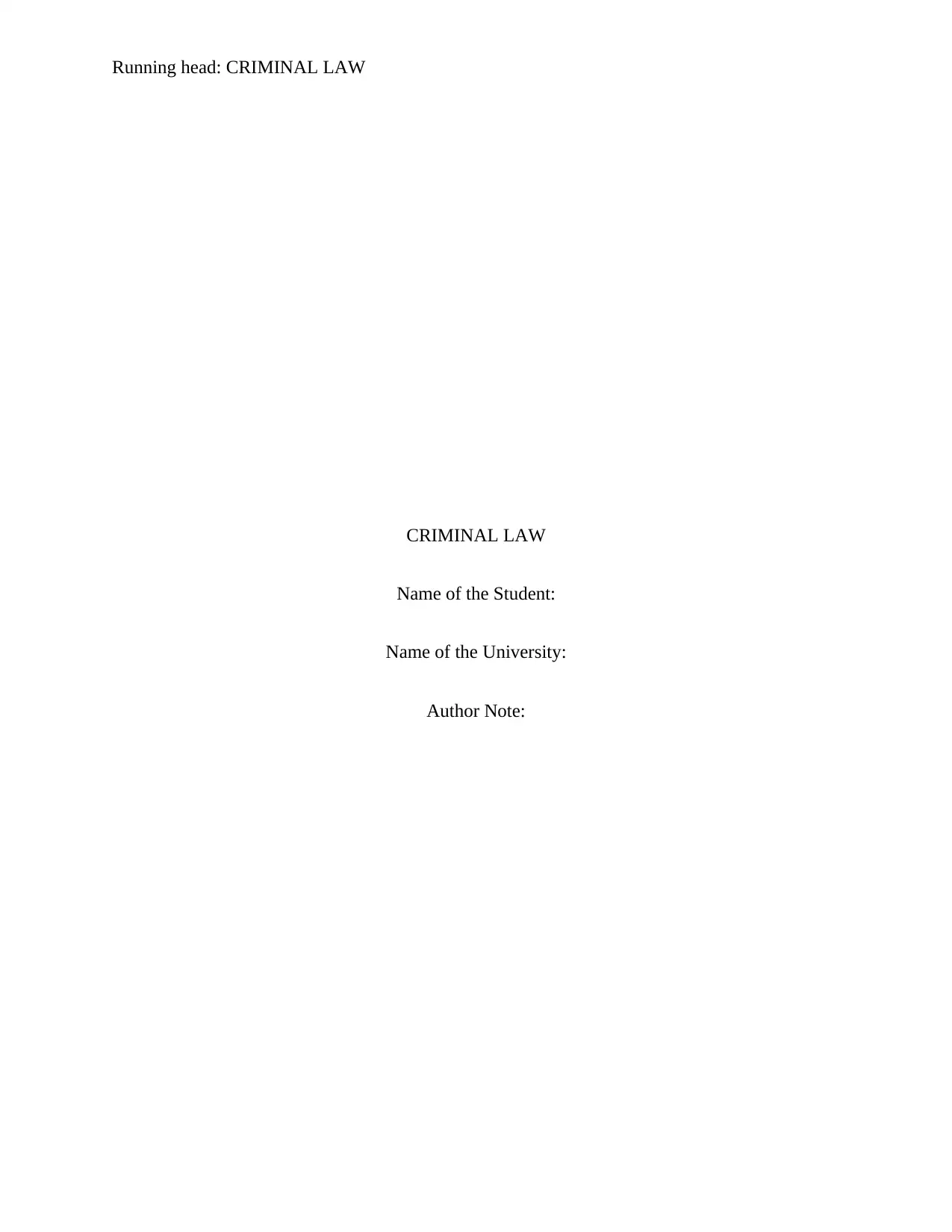
Running head: CRIMINAL LAW
CRIMINAL LAW
Name of the Student:
Name of the University:
Author Note:
CRIMINAL LAW
Name of the Student:
Name of the University:
Author Note:
Secure Best Marks with AI Grader
Need help grading? Try our AI Grader for instant feedback on your assignments.

1CRIMINAL LAW
Introduction:
The issue involved in this case is to identify the liability of Joe for Sam’s death and the
defences Joe might attempt to depend on to support his case.
Discussion:
In the present case, Joe will be first charged with murder contrary to section 18 of the
Crimes Act 1900(NSW), hereinafter referred to as Code1. For all homicide offences, the burden
of proving all the elements of the offence beyond reasonable doubt is on the prosecution as per
the Woolmington principle. The accused is to be presumed to be innocent until the offence is
proved. To prove the murder offence, the prosecution has to prove the charge of murder2.
Charge of murder:
The basic elements to be proved for the offence of murder are the actus reus and mens
rea. The general rule of proving murder is based on the maxim ‘actus non facit reum nisi mens
sit rea’ which means that the offence of murder can be said to be committed when the guilty act
is coupled with guilty mind.
Actus reus:
The term actus rea is a Latin term which means guilty act. It is the physical element of
the crime. It is usually defined as a criminal act that has resulted from voluntary body movement.
It refers to a physical activity that inflicts harm on another person or causes damage to a
1 The Crimes Act 1900(NSW), s. 18.
2 Fitz-Gibbon, Kate, Jude McCulloch, and JaneMaree Maher. "NSW Government Sentencing Council: Review of
sentencing for murder and manslaughter." (2019).
Introduction:
The issue involved in this case is to identify the liability of Joe for Sam’s death and the
defences Joe might attempt to depend on to support his case.
Discussion:
In the present case, Joe will be first charged with murder contrary to section 18 of the
Crimes Act 1900(NSW), hereinafter referred to as Code1. For all homicide offences, the burden
of proving all the elements of the offence beyond reasonable doubt is on the prosecution as per
the Woolmington principle. The accused is to be presumed to be innocent until the offence is
proved. To prove the murder offence, the prosecution has to prove the charge of murder2.
Charge of murder:
The basic elements to be proved for the offence of murder are the actus reus and mens
rea. The general rule of proving murder is based on the maxim ‘actus non facit reum nisi mens
sit rea’ which means that the offence of murder can be said to be committed when the guilty act
is coupled with guilty mind.
Actus reus:
The term actus rea is a Latin term which means guilty act. It is the physical element of
the crime. It is usually defined as a criminal act that has resulted from voluntary body movement.
It refers to a physical activity that inflicts harm on another person or causes damage to a
1 The Crimes Act 1900(NSW), s. 18.
2 Fitz-Gibbon, Kate, Jude McCulloch, and JaneMaree Maher. "NSW Government Sentencing Council: Review of
sentencing for murder and manslaughter." (2019).
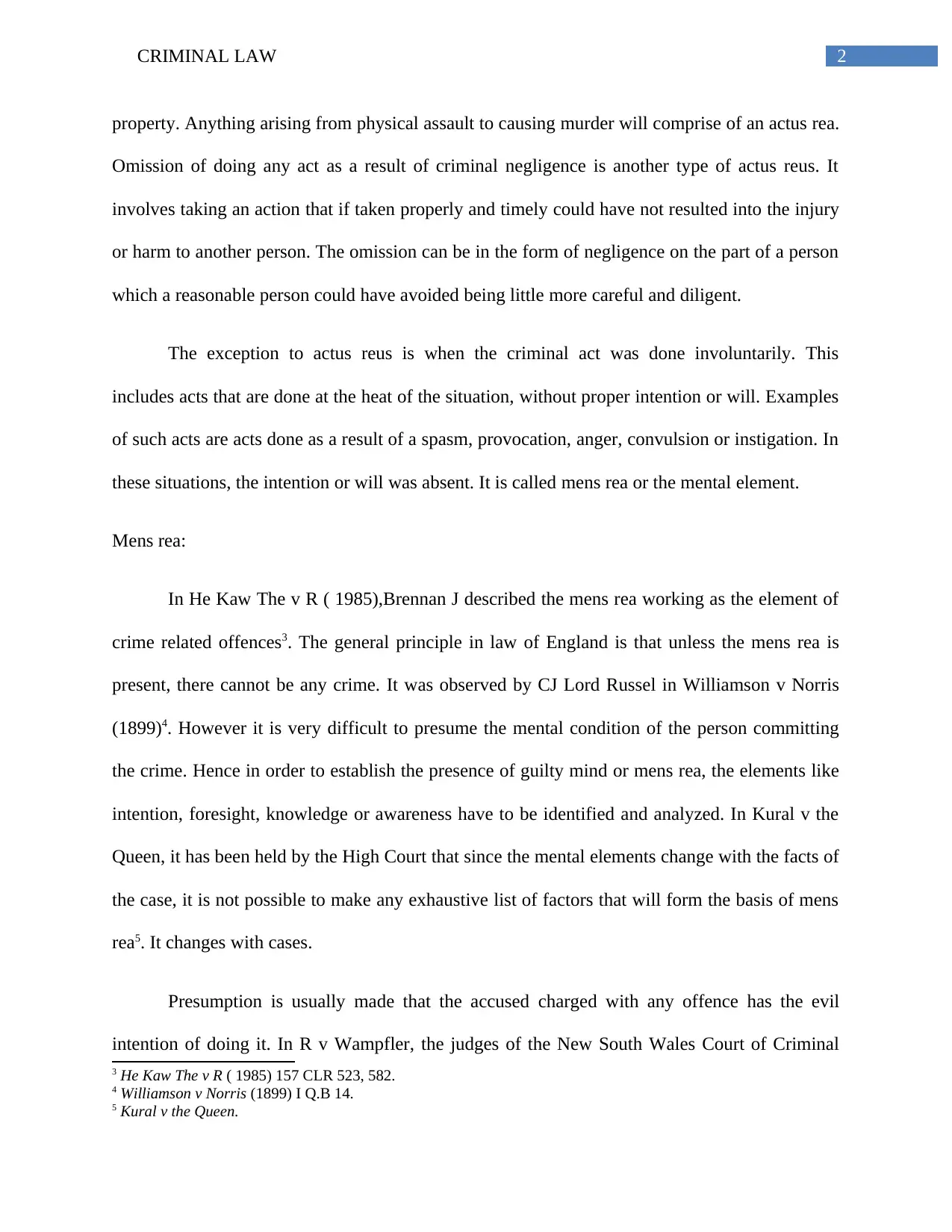
2CRIMINAL LAW
property. Anything arising from physical assault to causing murder will comprise of an actus rea.
Omission of doing any act as a result of criminal negligence is another type of actus reus. It
involves taking an action that if taken properly and timely could have not resulted into the injury
or harm to another person. The omission can be in the form of negligence on the part of a person
which a reasonable person could have avoided being little more careful and diligent.
The exception to actus reus is when the criminal act was done involuntarily. This
includes acts that are done at the heat of the situation, without proper intention or will. Examples
of such acts are acts done as a result of a spasm, provocation, anger, convulsion or instigation. In
these situations, the intention or will was absent. It is called mens rea or the mental element.
Mens rea:
In He Kaw The v R ( 1985),Brennan J described the mens rea working as the element of
crime related offences3. The general principle in law of England is that unless the mens rea is
present, there cannot be any crime. It was observed by CJ Lord Russel in Williamson v Norris
(1899)4. However it is very difficult to presume the mental condition of the person committing
the crime. Hence in order to establish the presence of guilty mind or mens rea, the elements like
intention, foresight, knowledge or awareness have to be identified and analyzed. In Kural v the
Queen, it has been held by the High Court that since the mental elements change with the facts of
the case, it is not possible to make any exhaustive list of factors that will form the basis of mens
rea5. It changes with cases.
Presumption is usually made that the accused charged with any offence has the evil
intention of doing it. In R v Wampfler, the judges of the New South Wales Court of Criminal
3 He Kaw The v R ( 1985) 157 CLR 523, 582.
4 Williamson v Norris (1899) I Q.B 14.
5 Kural v the Queen.
property. Anything arising from physical assault to causing murder will comprise of an actus rea.
Omission of doing any act as a result of criminal negligence is another type of actus reus. It
involves taking an action that if taken properly and timely could have not resulted into the injury
or harm to another person. The omission can be in the form of negligence on the part of a person
which a reasonable person could have avoided being little more careful and diligent.
The exception to actus reus is when the criminal act was done involuntarily. This
includes acts that are done at the heat of the situation, without proper intention or will. Examples
of such acts are acts done as a result of a spasm, provocation, anger, convulsion or instigation. In
these situations, the intention or will was absent. It is called mens rea or the mental element.
Mens rea:
In He Kaw The v R ( 1985),Brennan J described the mens rea working as the element of
crime related offences3. The general principle in law of England is that unless the mens rea is
present, there cannot be any crime. It was observed by CJ Lord Russel in Williamson v Norris
(1899)4. However it is very difficult to presume the mental condition of the person committing
the crime. Hence in order to establish the presence of guilty mind or mens rea, the elements like
intention, foresight, knowledge or awareness have to be identified and analyzed. In Kural v the
Queen, it has been held by the High Court that since the mental elements change with the facts of
the case, it is not possible to make any exhaustive list of factors that will form the basis of mens
rea5. It changes with cases.
Presumption is usually made that the accused charged with any offence has the evil
intention of doing it. In R v Wampfler, the judges of the New South Wales Court of Criminal
3 He Kaw The v R ( 1985) 157 CLR 523, 582.
4 Williamson v Norris (1899) I Q.B 14.
5 Kural v the Queen.

3CRIMINAL LAW
Appeal, followed the decision given in the He Kaw Teh v The Queen held that the obligation lies
on the prosecution to prove the mens rea, which is the main obligation, in the cases where mens
rea is presumed to be present, the prosecution has the duty of negating it, the guilt is proved by
the objective criteria of the offence and there is no mens rea in it6. Section 56 of the Criminal
Code (Cth) provides a reasonable that in order to prove guilt; the fault is to be proved for each of
the physical elements of the Commonwealth offence7.
In the present case, the Joe was liable of murdering Sam. The prosecution has the burden
of proving all the elements to the standard of beyond of reasonable doubt as observed in the case
of Woolmington v DPP [1935] which is the landmark case of the House of Lords where the
presumption of innocence was first formulated in the Commonwealth8. According to the
Woolmington principal, the prosecution must prove the guilt of the accused and there is no
burden on the accused to prove his innocence. It is called the ‘golden thread’ which based on the
‘presumption of innocence’ in the English Common law. In the Privy Council case of Jayasena v
the Queen [1970] AC 618, it was observed that the defended is required to collect evidences ‘to
make it possible for a reasonable jury to acquit’9.
In the present case, actus rea was present in the context of positive act and not omission.
There lies a question whether the act of Joe was willed or conscious. When there is nothing to
show that the conduct of the accused is being willed or conscious the presumption is that the act
was voluntary. The accused can rebut it by an evidentiary burden and then the prosecution is
required to prove that the act was voluntary beyond all reasonable doubt ( Falconer 1990 171
CLR 30) as laid in the Woolmington principle. In this case, Joe’s act was voluntary and willed.
6 R v Wampfler.
7 The Criminal Code (Cth), s. 56.
8 Woolmington v DPP [1935] UKHL 1.
9 Jayasena v the Queen [1970] AC 618.
Appeal, followed the decision given in the He Kaw Teh v The Queen held that the obligation lies
on the prosecution to prove the mens rea, which is the main obligation, in the cases where mens
rea is presumed to be present, the prosecution has the duty of negating it, the guilt is proved by
the objective criteria of the offence and there is no mens rea in it6. Section 56 of the Criminal
Code (Cth) provides a reasonable that in order to prove guilt; the fault is to be proved for each of
the physical elements of the Commonwealth offence7.
In the present case, the Joe was liable of murdering Sam. The prosecution has the burden
of proving all the elements to the standard of beyond of reasonable doubt as observed in the case
of Woolmington v DPP [1935] which is the landmark case of the House of Lords where the
presumption of innocence was first formulated in the Commonwealth8. According to the
Woolmington principal, the prosecution must prove the guilt of the accused and there is no
burden on the accused to prove his innocence. It is called the ‘golden thread’ which based on the
‘presumption of innocence’ in the English Common law. In the Privy Council case of Jayasena v
the Queen [1970] AC 618, it was observed that the defended is required to collect evidences ‘to
make it possible for a reasonable jury to acquit’9.
In the present case, actus rea was present in the context of positive act and not omission.
There lies a question whether the act of Joe was willed or conscious. When there is nothing to
show that the conduct of the accused is being willed or conscious the presumption is that the act
was voluntary. The accused can rebut it by an evidentiary burden and then the prosecution is
required to prove that the act was voluntary beyond all reasonable doubt ( Falconer 1990 171
CLR 30) as laid in the Woolmington principle. In this case, Joe’s act was voluntary and willed.
6 R v Wampfler.
7 The Criminal Code (Cth), s. 56.
8 Woolmington v DPP [1935] UKHL 1.
9 Jayasena v the Queen [1970] AC 618.
Secure Best Marks with AI Grader
Need help grading? Try our AI Grader for instant feedback on your assignments.
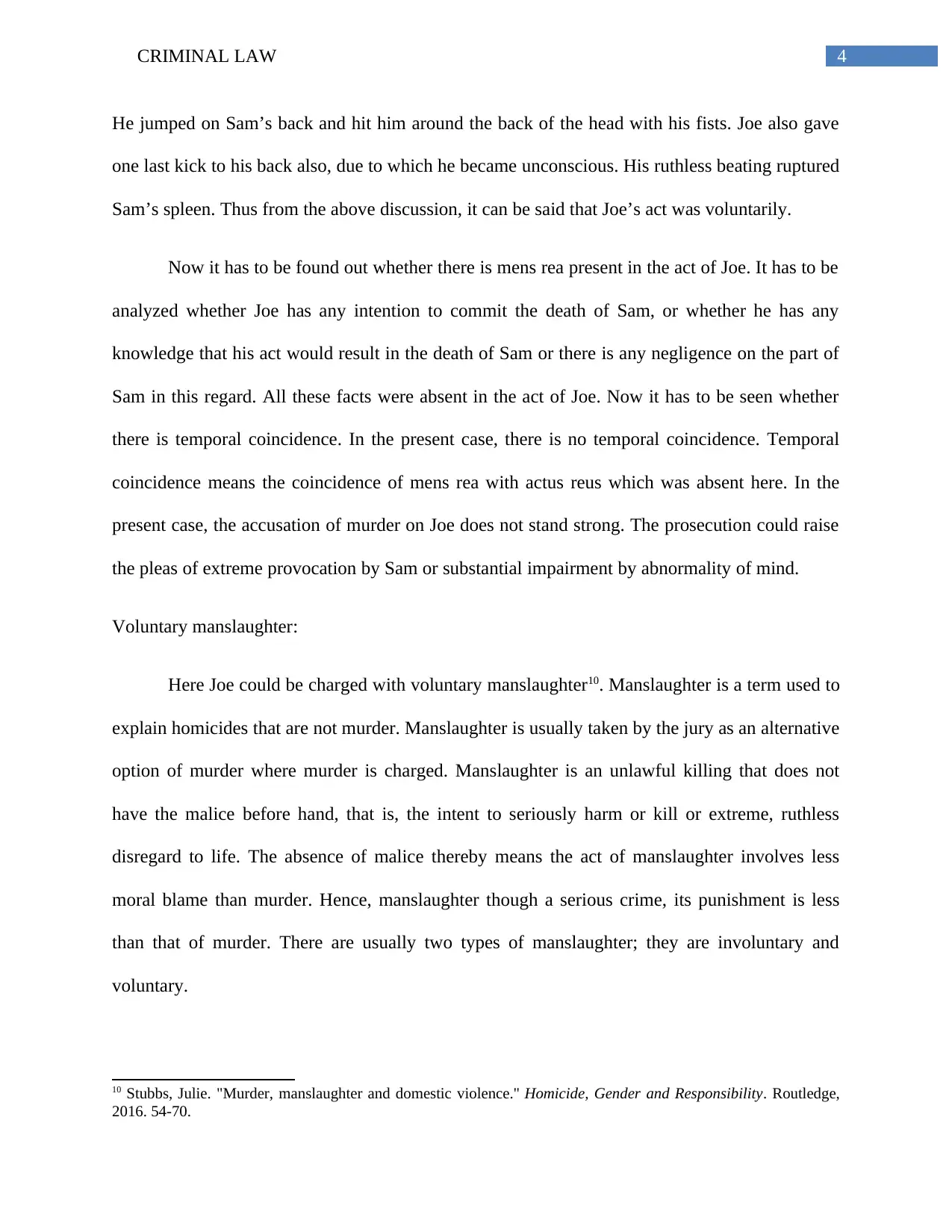
4CRIMINAL LAW
He jumped on Sam’s back and hit him around the back of the head with his fists. Joe also gave
one last kick to his back also, due to which he became unconscious. His ruthless beating ruptured
Sam’s spleen. Thus from the above discussion, it can be said that Joe’s act was voluntarily.
Now it has to be found out whether there is mens rea present in the act of Joe. It has to be
analyzed whether Joe has any intention to commit the death of Sam, or whether he has any
knowledge that his act would result in the death of Sam or there is any negligence on the part of
Sam in this regard. All these facts were absent in the act of Joe. Now it has to be seen whether
there is temporal coincidence. In the present case, there is no temporal coincidence. Temporal
coincidence means the coincidence of mens rea with actus reus which was absent here. In the
present case, the accusation of murder on Joe does not stand strong. The prosecution could raise
the pleas of extreme provocation by Sam or substantial impairment by abnormality of mind.
Voluntary manslaughter:
Here Joe could be charged with voluntary manslaughter10. Manslaughter is a term used to
explain homicides that are not murder. Manslaughter is usually taken by the jury as an alternative
option of murder where murder is charged. Manslaughter is an unlawful killing that does not
have the malice before hand, that is, the intent to seriously harm or kill or extreme, ruthless
disregard to life. The absence of malice thereby means the act of manslaughter involves less
moral blame than murder. Hence, manslaughter though a serious crime, its punishment is less
than that of murder. There are usually two types of manslaughter; they are involuntary and
voluntary.
10 Stubbs, Julie. "Murder, manslaughter and domestic violence." Homicide, Gender and Responsibility. Routledge,
2016. 54-70.
He jumped on Sam’s back and hit him around the back of the head with his fists. Joe also gave
one last kick to his back also, due to which he became unconscious. His ruthless beating ruptured
Sam’s spleen. Thus from the above discussion, it can be said that Joe’s act was voluntarily.
Now it has to be found out whether there is mens rea present in the act of Joe. It has to be
analyzed whether Joe has any intention to commit the death of Sam, or whether he has any
knowledge that his act would result in the death of Sam or there is any negligence on the part of
Sam in this regard. All these facts were absent in the act of Joe. Now it has to be seen whether
there is temporal coincidence. In the present case, there is no temporal coincidence. Temporal
coincidence means the coincidence of mens rea with actus reus which was absent here. In the
present case, the accusation of murder on Joe does not stand strong. The prosecution could raise
the pleas of extreme provocation by Sam or substantial impairment by abnormality of mind.
Voluntary manslaughter:
Here Joe could be charged with voluntary manslaughter10. Manslaughter is a term used to
explain homicides that are not murder. Manslaughter is usually taken by the jury as an alternative
option of murder where murder is charged. Manslaughter is an unlawful killing that does not
have the malice before hand, that is, the intent to seriously harm or kill or extreme, ruthless
disregard to life. The absence of malice thereby means the act of manslaughter involves less
moral blame than murder. Hence, manslaughter though a serious crime, its punishment is less
than that of murder. There are usually two types of manslaughter; they are involuntary and
voluntary.
10 Stubbs, Julie. "Murder, manslaughter and domestic violence." Homicide, Gender and Responsibility. Routledge,
2016. 54-70.
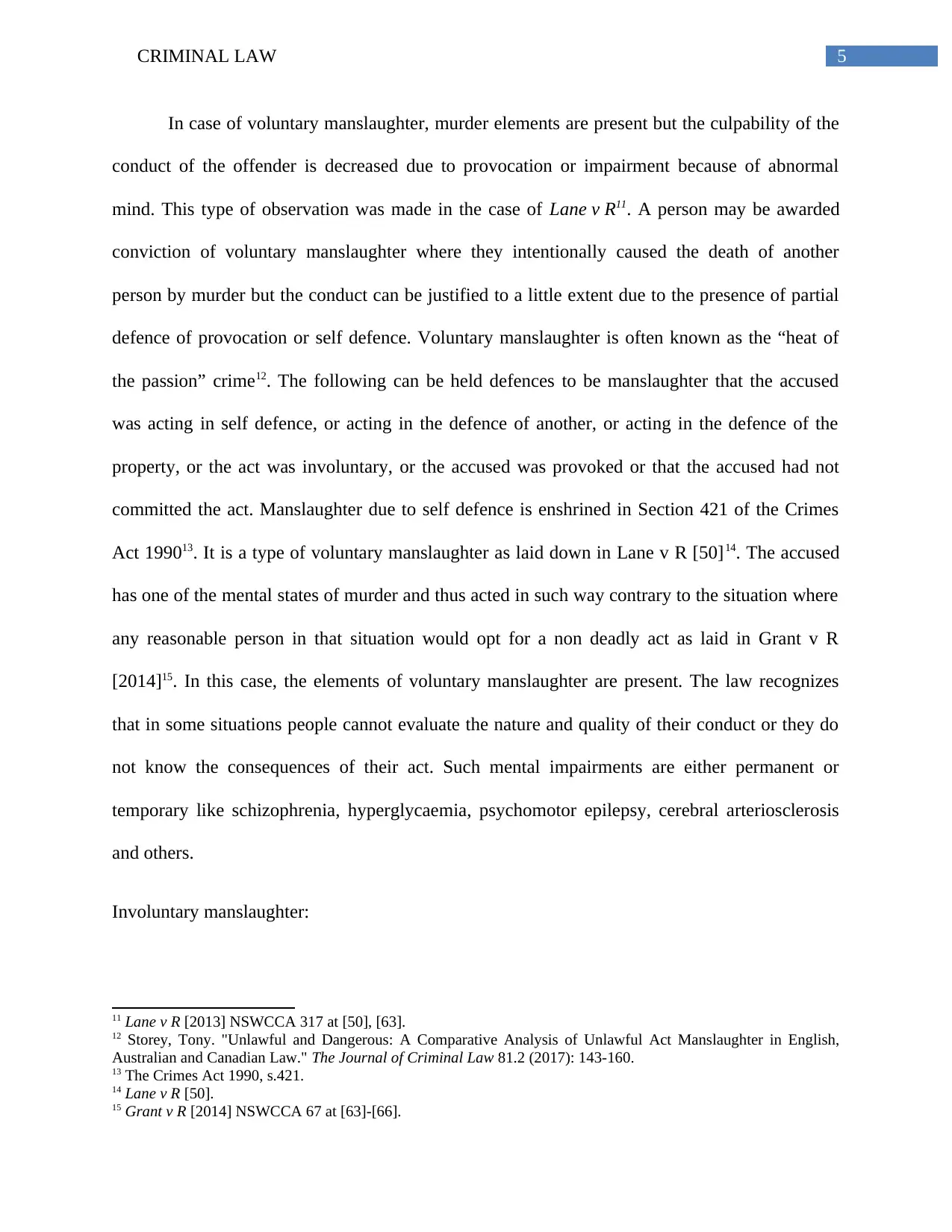
5CRIMINAL LAW
In case of voluntary manslaughter, murder elements are present but the culpability of the
conduct of the offender is decreased due to provocation or impairment because of abnormal
mind. This type of observation was made in the case of Lane v R11. A person may be awarded
conviction of voluntary manslaughter where they intentionally caused the death of another
person by murder but the conduct can be justified to a little extent due to the presence of partial
defence of provocation or self defence. Voluntary manslaughter is often known as the “heat of
the passion” crime12. The following can be held defences to be manslaughter that the accused
was acting in self defence, or acting in the defence of another, or acting in the defence of the
property, or the act was involuntary, or the accused was provoked or that the accused had not
committed the act. Manslaughter due to self defence is enshrined in Section 421 of the Crimes
Act 199013. It is a type of voluntary manslaughter as laid down in Lane v R [50]14. The accused
has one of the mental states of murder and thus acted in such way contrary to the situation where
any reasonable person in that situation would opt for a non deadly act as laid in Grant v R
[2014]15. In this case, the elements of voluntary manslaughter are present. The law recognizes
that in some situations people cannot evaluate the nature and quality of their conduct or they do
not know the consequences of their act. Such mental impairments are either permanent or
temporary like schizophrenia, hyperglycaemia, psychomotor epilepsy, cerebral arteriosclerosis
and others.
Involuntary manslaughter:
11 Lane v R [2013] NSWCCA 317 at [50], [63].
12 Storey, Tony. "Unlawful and Dangerous: A Comparative Analysis of Unlawful Act Manslaughter in English,
Australian and Canadian Law." The Journal of Criminal Law 81.2 (2017): 143-160.
13 The Crimes Act 1990, s.421.
14 Lane v R [50].
15 Grant v R [2014] NSWCCA 67 at [63]-[66].
In case of voluntary manslaughter, murder elements are present but the culpability of the
conduct of the offender is decreased due to provocation or impairment because of abnormal
mind. This type of observation was made in the case of Lane v R11. A person may be awarded
conviction of voluntary manslaughter where they intentionally caused the death of another
person by murder but the conduct can be justified to a little extent due to the presence of partial
defence of provocation or self defence. Voluntary manslaughter is often known as the “heat of
the passion” crime12. The following can be held defences to be manslaughter that the accused
was acting in self defence, or acting in the defence of another, or acting in the defence of the
property, or the act was involuntary, or the accused was provoked or that the accused had not
committed the act. Manslaughter due to self defence is enshrined in Section 421 of the Crimes
Act 199013. It is a type of voluntary manslaughter as laid down in Lane v R [50]14. The accused
has one of the mental states of murder and thus acted in such way contrary to the situation where
any reasonable person in that situation would opt for a non deadly act as laid in Grant v R
[2014]15. In this case, the elements of voluntary manslaughter are present. The law recognizes
that in some situations people cannot evaluate the nature and quality of their conduct or they do
not know the consequences of their act. Such mental impairments are either permanent or
temporary like schizophrenia, hyperglycaemia, psychomotor epilepsy, cerebral arteriosclerosis
and others.
Involuntary manslaughter:
11 Lane v R [2013] NSWCCA 317 at [50], [63].
12 Storey, Tony. "Unlawful and Dangerous: A Comparative Analysis of Unlawful Act Manslaughter in English,
Australian and Canadian Law." The Journal of Criminal Law 81.2 (2017): 143-160.
13 The Crimes Act 1990, s.421.
14 Lane v R [50].
15 Grant v R [2014] NSWCCA 67 at [63]-[66].
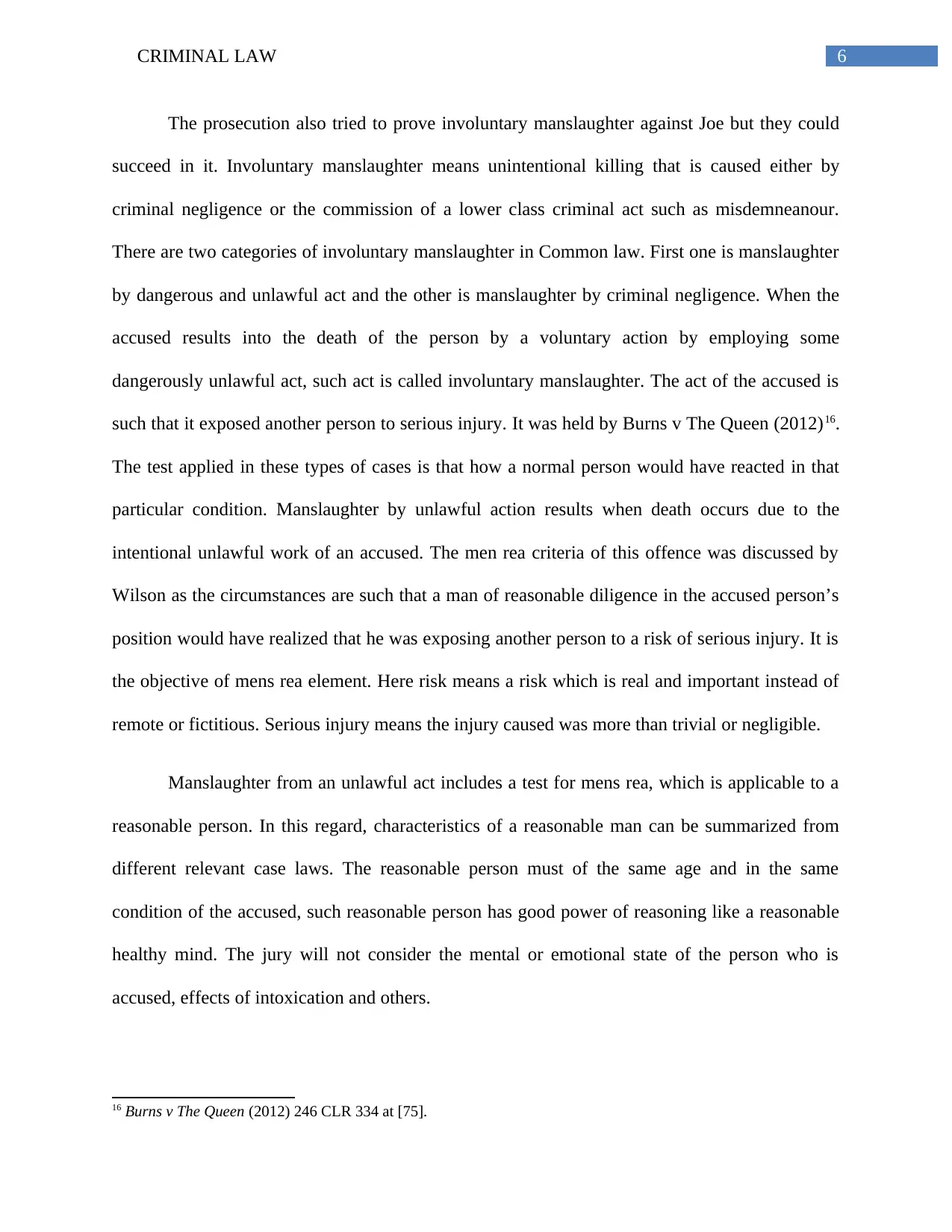
6CRIMINAL LAW
The prosecution also tried to prove involuntary manslaughter against Joe but they could
succeed in it. Involuntary manslaughter means unintentional killing that is caused either by
criminal negligence or the commission of a lower class criminal act such as misdemneanour.
There are two categories of involuntary manslaughter in Common law. First one is manslaughter
by dangerous and unlawful act and the other is manslaughter by criminal negligence. When the
accused results into the death of the person by a voluntary action by employing some
dangerously unlawful act, such act is called involuntary manslaughter. The act of the accused is
such that it exposed another person to serious injury. It was held by Burns v The Queen (2012)16.
The test applied in these types of cases is that how a normal person would have reacted in that
particular condition. Manslaughter by unlawful action results when death occurs due to the
intentional unlawful work of an accused. The men rea criteria of this offence was discussed by
Wilson as the circumstances are such that a man of reasonable diligence in the accused person’s
position would have realized that he was exposing another person to a risk of serious injury. It is
the objective of mens rea element. Here risk means a risk which is real and important instead of
remote or fictitious. Serious injury means the injury caused was more than trivial or negligible.
Manslaughter from an unlawful act includes a test for mens rea, which is applicable to a
reasonable person. In this regard, characteristics of a reasonable man can be summarized from
different relevant case laws. The reasonable person must of the same age and in the same
condition of the accused, such reasonable person has good power of reasoning like a reasonable
healthy mind. The jury will not consider the mental or emotional state of the person who is
accused, effects of intoxication and others.
16 Burns v The Queen (2012) 246 CLR 334 at [75].
The prosecution also tried to prove involuntary manslaughter against Joe but they could
succeed in it. Involuntary manslaughter means unintentional killing that is caused either by
criminal negligence or the commission of a lower class criminal act such as misdemneanour.
There are two categories of involuntary manslaughter in Common law. First one is manslaughter
by dangerous and unlawful act and the other is manslaughter by criminal negligence. When the
accused results into the death of the person by a voluntary action by employing some
dangerously unlawful act, such act is called involuntary manslaughter. The act of the accused is
such that it exposed another person to serious injury. It was held by Burns v The Queen (2012)16.
The test applied in these types of cases is that how a normal person would have reacted in that
particular condition. Manslaughter by unlawful action results when death occurs due to the
intentional unlawful work of an accused. The men rea criteria of this offence was discussed by
Wilson as the circumstances are such that a man of reasonable diligence in the accused person’s
position would have realized that he was exposing another person to a risk of serious injury. It is
the objective of mens rea element. Here risk means a risk which is real and important instead of
remote or fictitious. Serious injury means the injury caused was more than trivial or negligible.
Manslaughter from an unlawful act includes a test for mens rea, which is applicable to a
reasonable person. In this regard, characteristics of a reasonable man can be summarized from
different relevant case laws. The reasonable person must of the same age and in the same
condition of the accused, such reasonable person has good power of reasoning like a reasonable
healthy mind. The jury will not consider the mental or emotional state of the person who is
accused, effects of intoxication and others.
16 Burns v The Queen (2012) 246 CLR 334 at [75].
Paraphrase This Document
Need a fresh take? Get an instant paraphrase of this document with our AI Paraphraser

7CRIMINAL LAW
The actus reus of manslaughter from an unlawful act is not that the accused occurred
death but that act was actually unlawful. This was analyzed by Lamb in [1967]17. It means the act
is a criminal offence neither a tort nor regulatory infringement. The accused must possess
required mens rea for that unlawful act. Some unlawful acts that are excluded from manslaughter
by unlawful act are driving offences, administering drugs.
The second type of involuntary manslaughter is manslaughter by criminal negligence. It
is the act where the accused failed to take standard care that a reasonable person in a highly risky
situation would have taken. The main point of difference between manslaughter by criminal
negligence and manslaughter by unlawful act is that it is not necessary to prove that the act of
accused was unlawful. Nydam [1977]18 discussed the test for manslaughter by criminal
negligence.
Section 24 of the Crimes Act 1900 states the maximum punishment for manslaughter is
25 years19 imprisonment. Here Joe’s act cannot be proved for involuntary manslaughter. In this
case, the charge against Joe being accused of involuntary manslaughter cannot succeed due to
lack of evidence. Hence, charges of assault occasioning actual bodily harm can be brought
against Joe.
Reckless Grievous Bodily Harm:
Section 35(4), the Crimes Act 1900 provides provision of reckless grievous bodily
harm20. The maximum penalty for it is 7 years. It says that any person who wounds another
person recklessly resulting actual harm on body to that guilty offence for the offence of reckless
17 Lamb, [1967] 2 QB 981.
18 Nydam [1977] VR 430.
19 The Crimes Act 1900, s. 24.
20 The Crimes Act 1900, s. 35(4).
The actus reus of manslaughter from an unlawful act is not that the accused occurred
death but that act was actually unlawful. This was analyzed by Lamb in [1967]17. It means the act
is a criminal offence neither a tort nor regulatory infringement. The accused must possess
required mens rea for that unlawful act. Some unlawful acts that are excluded from manslaughter
by unlawful act are driving offences, administering drugs.
The second type of involuntary manslaughter is manslaughter by criminal negligence. It
is the act where the accused failed to take standard care that a reasonable person in a highly risky
situation would have taken. The main point of difference between manslaughter by criminal
negligence and manslaughter by unlawful act is that it is not necessary to prove that the act of
accused was unlawful. Nydam [1977]18 discussed the test for manslaughter by criminal
negligence.
Section 24 of the Crimes Act 1900 states the maximum punishment for manslaughter is
25 years19 imprisonment. Here Joe’s act cannot be proved for involuntary manslaughter. In this
case, the charge against Joe being accused of involuntary manslaughter cannot succeed due to
lack of evidence. Hence, charges of assault occasioning actual bodily harm can be brought
against Joe.
Reckless Grievous Bodily Harm:
Section 35(4), the Crimes Act 1900 provides provision of reckless grievous bodily
harm20. The maximum penalty for it is 7 years. It says that any person who wounds another
person recklessly resulting actual harm on body to that guilty offence for the offence of reckless
17 Lamb, [1967] 2 QB 981.
18 Nydam [1977] VR 430.
19 The Crimes Act 1900, s. 24.
20 The Crimes Act 1900, s. 35(4).
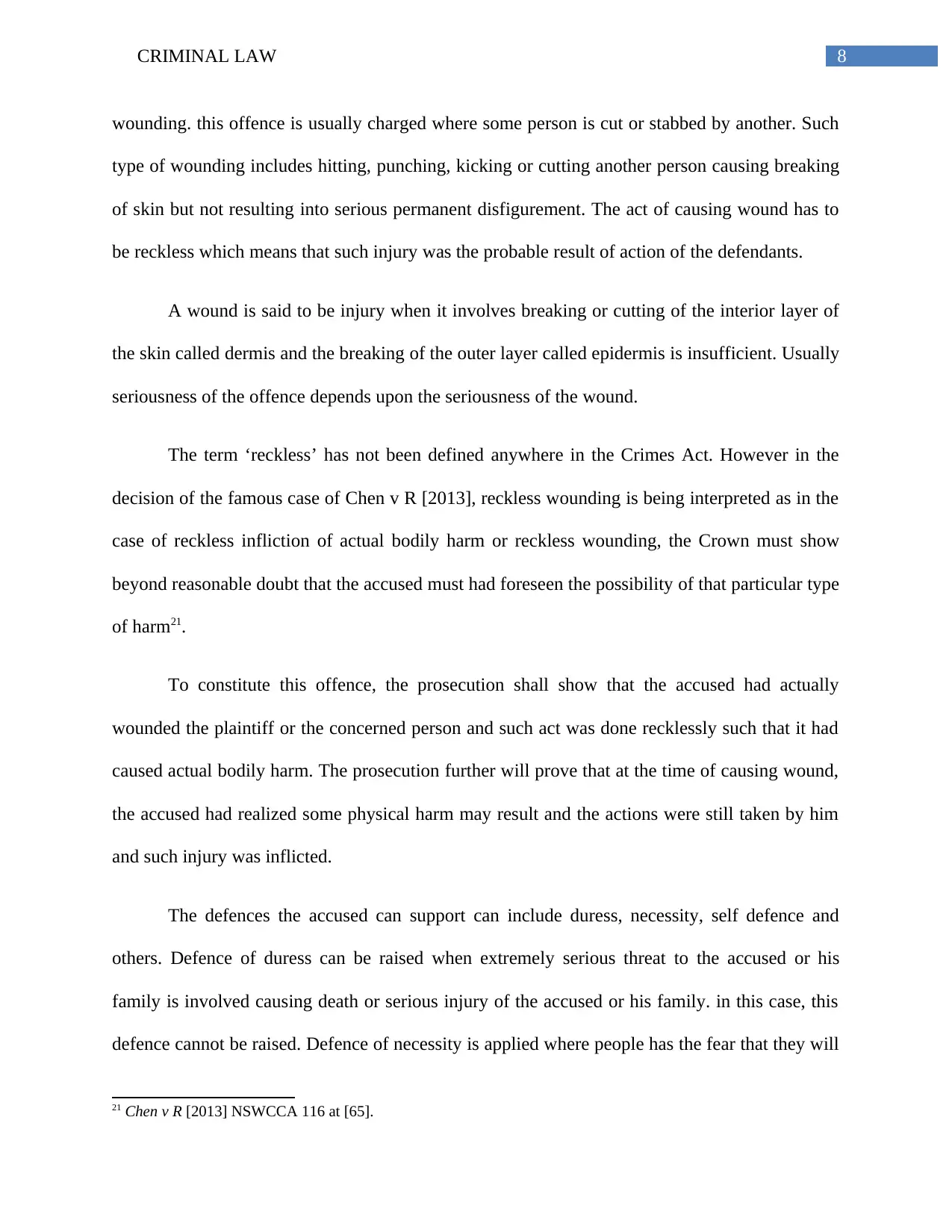
8CRIMINAL LAW
wounding. this offence is usually charged where some person is cut or stabbed by another. Such
type of wounding includes hitting, punching, kicking or cutting another person causing breaking
of skin but not resulting into serious permanent disfigurement. The act of causing wound has to
be reckless which means that such injury was the probable result of action of the defendants.
A wound is said to be injury when it involves breaking or cutting of the interior layer of
the skin called dermis and the breaking of the outer layer called epidermis is insufficient. Usually
seriousness of the offence depends upon the seriousness of the wound.
The term ‘reckless’ has not been defined anywhere in the Crimes Act. However in the
decision of the famous case of Chen v R [2013], reckless wounding is being interpreted as in the
case of reckless infliction of actual bodily harm or reckless wounding, the Crown must show
beyond reasonable doubt that the accused must had foreseen the possibility of that particular type
of harm21.
To constitute this offence, the prosecution shall show that the accused had actually
wounded the plaintiff or the concerned person and such act was done recklessly such that it had
caused actual bodily harm. The prosecution further will prove that at the time of causing wound,
the accused had realized some physical harm may result and the actions were still taken by him
and such injury was inflicted.
The defences the accused can support can include duress, necessity, self defence and
others. Defence of duress can be raised when extremely serious threat to the accused or his
family is involved causing death or serious injury of the accused or his family. in this case, this
defence cannot be raised. Defence of necessity is applied where people has the fear that they will
21 Chen v R [2013] NSWCCA 116 at [65].
wounding. this offence is usually charged where some person is cut or stabbed by another. Such
type of wounding includes hitting, punching, kicking or cutting another person causing breaking
of skin but not resulting into serious permanent disfigurement. The act of causing wound has to
be reckless which means that such injury was the probable result of action of the defendants.
A wound is said to be injury when it involves breaking or cutting of the interior layer of
the skin called dermis and the breaking of the outer layer called epidermis is insufficient. Usually
seriousness of the offence depends upon the seriousness of the wound.
The term ‘reckless’ has not been defined anywhere in the Crimes Act. However in the
decision of the famous case of Chen v R [2013], reckless wounding is being interpreted as in the
case of reckless infliction of actual bodily harm or reckless wounding, the Crown must show
beyond reasonable doubt that the accused must had foreseen the possibility of that particular type
of harm21.
To constitute this offence, the prosecution shall show that the accused had actually
wounded the plaintiff or the concerned person and such act was done recklessly such that it had
caused actual bodily harm. The prosecution further will prove that at the time of causing wound,
the accused had realized some physical harm may result and the actions were still taken by him
and such injury was inflicted.
The defences the accused can support can include duress, necessity, self defence and
others. Defence of duress can be raised when extremely serious threat to the accused or his
family is involved causing death or serious injury of the accused or his family. in this case, this
defence cannot be raised. Defence of necessity is applied where people has the fear that they will
21 Chen v R [2013] NSWCCA 116 at [65].
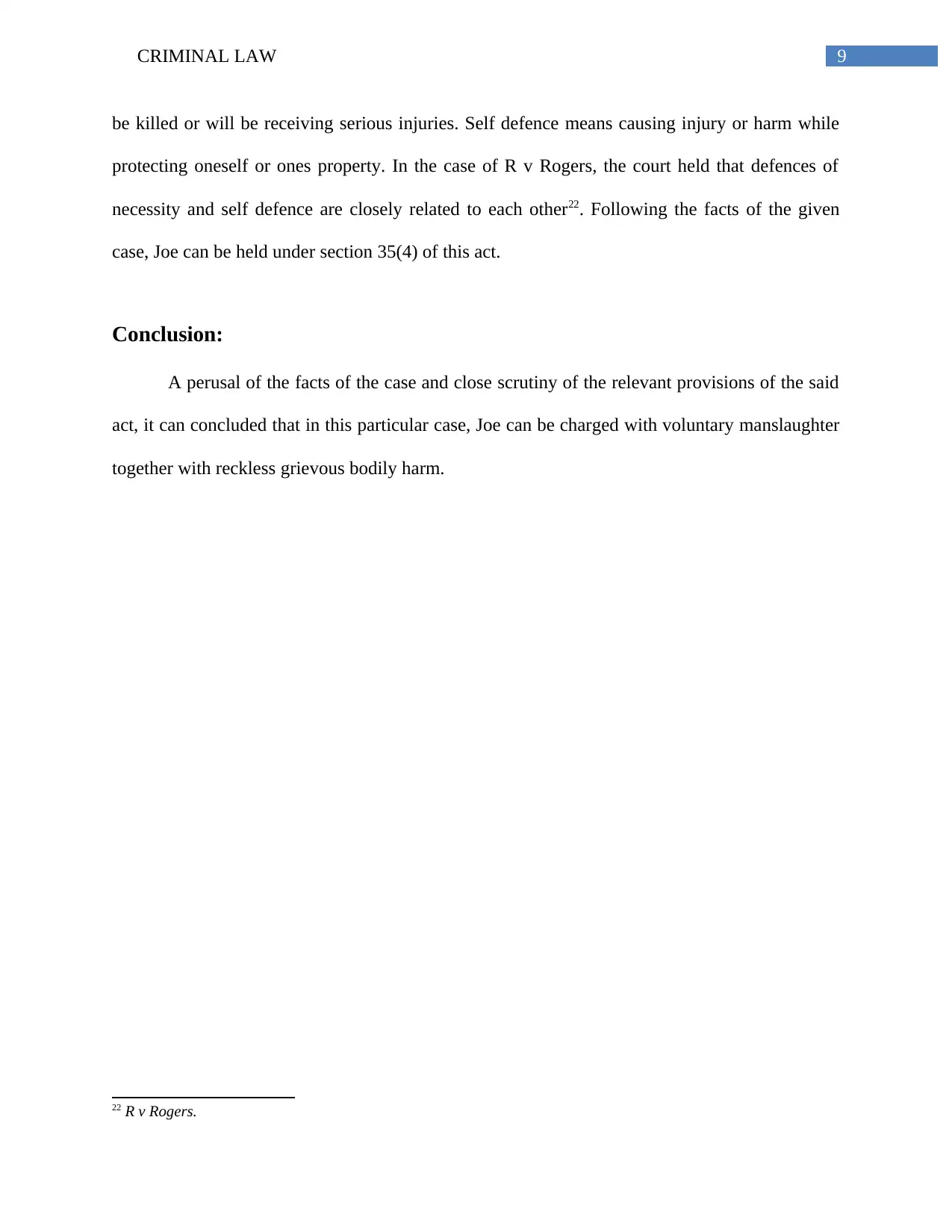
9CRIMINAL LAW
be killed or will be receiving serious injuries. Self defence means causing injury or harm while
protecting oneself or ones property. In the case of R v Rogers, the court held that defences of
necessity and self defence are closely related to each other22. Following the facts of the given
case, Joe can be held under section 35(4) of this act.
Conclusion:
A perusal of the facts of the case and close scrutiny of the relevant provisions of the said
act, it can concluded that in this particular case, Joe can be charged with voluntary manslaughter
together with reckless grievous bodily harm.
22 R v Rogers.
be killed or will be receiving serious injuries. Self defence means causing injury or harm while
protecting oneself or ones property. In the case of R v Rogers, the court held that defences of
necessity and self defence are closely related to each other22. Following the facts of the given
case, Joe can be held under section 35(4) of this act.
Conclusion:
A perusal of the facts of the case and close scrutiny of the relevant provisions of the said
act, it can concluded that in this particular case, Joe can be charged with voluntary manslaughter
together with reckless grievous bodily harm.
22 R v Rogers.
Secure Best Marks with AI Grader
Need help grading? Try our AI Grader for instant feedback on your assignments.

10CRIMINAL LAW
References:
Burns v The Queen (2012) 246 CLR 334 at [75]
Chen v R [2013] NSWCCA 116 at [65]
Fitz-Gibbon, Kate, Jude McCulloch, and JaneMaree Maher. "NSW Government Sentencing
Council: Review of sentencing for murder and manslaughter." (2019)
Grant v R [2014] NSWCCA 67 at [63]-[66]
He Kaw The v R ( 1985) 157 CLR 523, 582
Jayasena v the Queen [1970] AC 618
Kural v the Queen
Lamb, [1967] 2 QB 981
Lane v R [50]
Lane v R [2013] NSWCCA 317 at [50], [63]
Nydam [1977] VR 430
R v Rogers
R v Wampfler.
References:
Burns v The Queen (2012) 246 CLR 334 at [75]
Chen v R [2013] NSWCCA 116 at [65]
Fitz-Gibbon, Kate, Jude McCulloch, and JaneMaree Maher. "NSW Government Sentencing
Council: Review of sentencing for murder and manslaughter." (2019)
Grant v R [2014] NSWCCA 67 at [63]-[66]
He Kaw The v R ( 1985) 157 CLR 523, 582
Jayasena v the Queen [1970] AC 618
Kural v the Queen
Lamb, [1967] 2 QB 981
Lane v R [50]
Lane v R [2013] NSWCCA 317 at [50], [63]
Nydam [1977] VR 430
R v Rogers
R v Wampfler.

11CRIMINAL LAW
Storey, Tony. "Unlawful and Dangerous: A Comparative Analysis of Unlawful Act
Manslaughter in English, Australian and Canadian Law." The Journal of Criminal Law 81.2
(2017): 143-160
Stubbs, Julie. "Murder, manslaughter and domestic violence." Homicide, Gender and
Responsibility. Routledge, 2016. 54-70
The Crimes Act 1900(NSW), s. 18
The Crimes Act 1900, s. 24
The Crimes Act 1900, s. 35(4)
The Crimes Act 1990, s.421
The Criminal Code (Cth), s. 56
Williamson v Norris (1899) I Q.B 14
Woolmington v DPP [1935] UKHL 1
Storey, Tony. "Unlawful and Dangerous: A Comparative Analysis of Unlawful Act
Manslaughter in English, Australian and Canadian Law." The Journal of Criminal Law 81.2
(2017): 143-160
Stubbs, Julie. "Murder, manslaughter and domestic violence." Homicide, Gender and
Responsibility. Routledge, 2016. 54-70
The Crimes Act 1900(NSW), s. 18
The Crimes Act 1900, s. 24
The Crimes Act 1900, s. 35(4)
The Crimes Act 1990, s.421
The Criminal Code (Cth), s. 56
Williamson v Norris (1899) I Q.B 14
Woolmington v DPP [1935] UKHL 1
1 out of 12
Related Documents
Your All-in-One AI-Powered Toolkit for Academic Success.
+13062052269
info@desklib.com
Available 24*7 on WhatsApp / Email
![[object Object]](/_next/static/media/star-bottom.7253800d.svg)
Unlock your academic potential
© 2024 | Zucol Services PVT LTD | All rights reserved.





